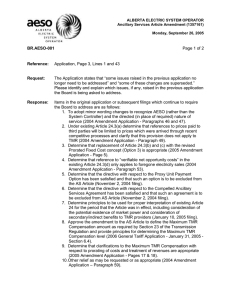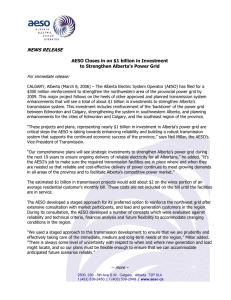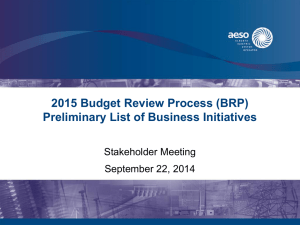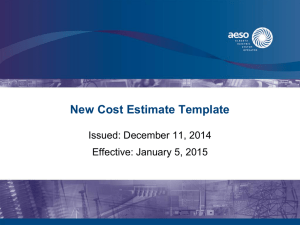ALBERTA ELECTRIC SYSTEM OPERATOR Ancillary Services Article Amendment (1357161)
advertisement
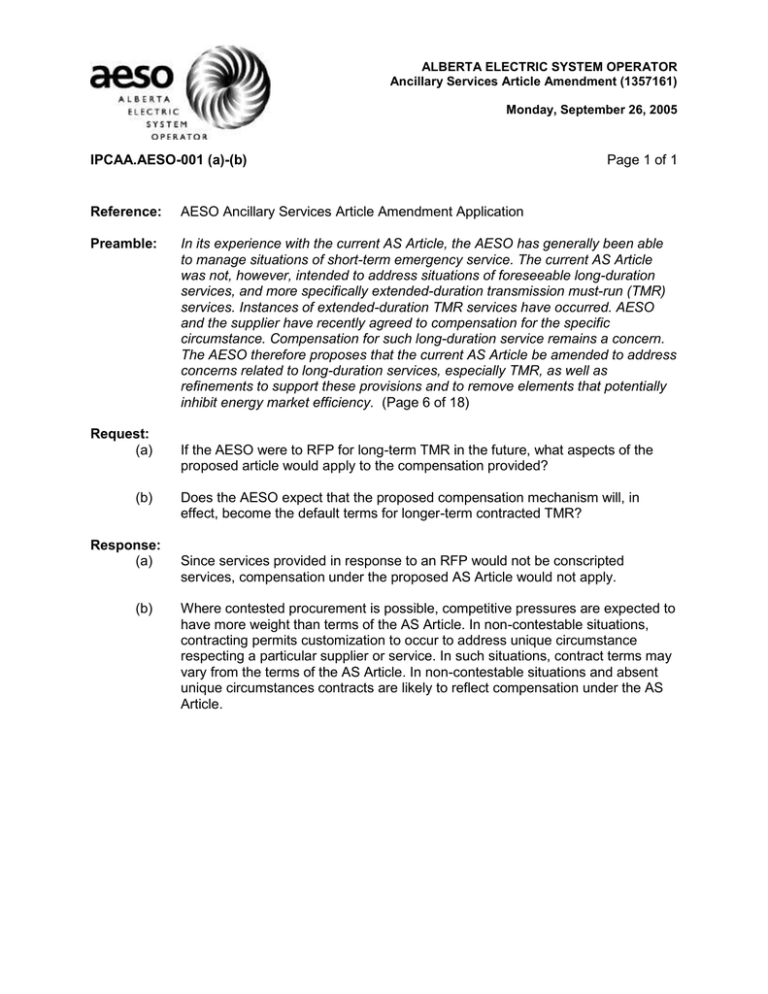
ALBERTA ELECTRIC SYSTEM OPERATOR Ancillary Services Article Amendment (1357161) Monday, September 26, 2005 IPCAA.AESO-001 (a)-(b) Page 1 of 1 Reference: AESO Ancillary Services Article Amendment Application Preamble: In its experience with the current AS Article, the AESO has generally been able to manage situations of short-term emergency service. The current AS Article was not, however, intended to address situations of foreseeable long-duration services, and more specifically extended-duration transmission must-run (TMR) services. Instances of extended-duration TMR services have occurred. AESO and the supplier have recently agreed to compensation for the specific circumstance. Compensation for such long-duration service remains a concern. The AESO therefore proposes that the current AS Article be amended to address concerns related to long-duration services, especially TMR, as well as refinements to support these provisions and to remove elements that potentially inhibit energy market efficiency. (Page 6 of 18) Request: (a) (b) Response: (a) (b) If the AESO were to RFP for long-term TMR in the future, what aspects of the proposed article would apply to the compensation provided? Does the AESO expect that the proposed compensation mechanism will, in effect, become the default terms for longer-term contracted TMR? Since services provided in response to an RFP would not be conscripted services, compensation under the proposed AS Article would not apply. Where contested procurement is possible, competitive pressures are expected to have more weight than terms of the AS Article. In non-contestable situations, contracting permits customization to occur to address unique circumstance respecting a particular supplier or service. In such situations, contract terms may vary from the terms of the AS Article. In non-contestable situations and absent unique circumstances contracts are likely to reflect compensation under the AS Article. ALBERTA ELECTRIC SYSTEM OPERATOR Ancillary Services Article Amendment (1357161) Monday, September 26, 2005 IPCAA.AESO-002 (a)-(d) Reference: AESO Ancillary Services Article Amendment Application Preamble: Section 23 of Transmission Regulation Page 1 of 2 The Transmission Regulation specifies “the compensation must be no greater than an amount that would result in the recovery of fixed, operating and maintenance costs, including a reasonable rate of return”. Request: (a) Is it the AESO’s view that the compensation referred to in the regulation relates only to the compensation provided by the AESO and only to compensation paid for provision of TMR services? (b) In the AESO’s view, can the regulation be read to include all compensation received by a generating unit owner, including that from the energy market? If not, please explain. (c) Please explain why the AESO proposal adopts a cost of service approach to determining compensation for any amount of TMR operation, whereas the transmission regulation merely stipulates that there should be a cap on TMR compensation based on cost of service. (d) Please provide the AESO’s view as to the time period that should be considered when interpreting the provision of the Transmission Regulation that states maximum compensation for TMR operation should be limited to the cost of service. Should this be read to apply to each hour, a month or a year? Please fully explain the AESO’s view on this matter. Response: (a) (b) Yes. No. AESO interprets section 23 of the Transmission Regulation to concern the maximum compensation amount that the AESO may pay to a generation unit owner for TMR service and not amounts that the generating unit owner may obtain from all sources, including energy market transactions. This view is supported by the fact that section 23 of the Regulation expressly refers to section 30(2)(a)(ii) of the Electric Utilities Act. This section of the Act concerns the types of costs that the AESO may include in its revenue requirement and then recover from rate-payers through its approved tariff. Section 30(2)(a)(ii) does not contemplate the AESO recovering amounts which a generating unit owner may otherwise obtain through the energy market. As such, other sources of revenue earned by the generating unit owner would not seem to have applicability to the AESO under section 23 of the Regulation or section 30(2)(a)(ii) of the Act. Page 2 of 2 (c) The Transmission Development Policy paper released on November 2003 stated at page 7 that “… TMR contracts should be provided on a cost-of-service basis by the owner…”. The ADOE’s Electricity Policy Framework paper as discussed at page 7 of the Amendment Application cites a cost of service principle, that being principle #8 (page 8, line 1 of Amendment Application). (d) Settlement on a monthly basis and on the basis of a monthly cost of service is proposed. Monthly settlements are a typical business practice and consistent with AESO’s transmission billing, the Power Pool and the Ancillary services market. 2 ALBERTA ELECTRIC SYSTEM OPERATOR Ancillary Services Article Amendment (1357161) Monday, September 26, 2005 IPCAA.AESO-003 (a)-(b) Reference: AESO Ancillary Services Article Amendment Application Preamble: 2.1 ADOE-Endorsed Principles for Compensation of TMR Services Request: (a) (b) Response: (a) (b) Page 1 of 1 6. To promote generation investor confidence, compensation for conscripted TMR services must be codified into the ISO’s terms and conditions. This includes provision of a cost of service cap for TMR mandated by the Transmission Regulation. 8. The ISO’s authority to conscript service should not result in unreasonable compensation for TMR service. Compensation must cover variable operating costs at a minimum and provide for recovery of fixed costs prorated according to joint use of the unit (i.e. TMR and the energy market). (Pages 7-8 of 18, underline added) What weight does the AESO feel the Board should place on the ADOE principles discussed in Section 2.1? Is the Board free to ignore the ADOE-endorsed principles? Does the AESO agree that its proposal allocates fixed costs between the energy market and provision of TMR but does not allocate the “recovery” of those costs as it ignores the margin earned in the energy market? If the AESO does not agree, please explain. AESO believes significant weight should be given to the principles. AESO has attempted to present a solution which is consistent with the ADOE principles and believes that it has accomplished that goal. Ultimately, it is up to the Board to decide the weight that is assigned to the evidence in determining the fairness and reasonableness of the applied for amendments. AESO agrees that its proposal allocates the fixed costs between the energy market and provision of TMR. AESO’s proposal also includes recovery of the TMR portion of fixed costs. The customer’s participation in the energy market, the revenues derived from the market and the remaining portion of the costs are left to the account of the customer. Such an approach minimizes the interference in the energy market which is one of the principles being followed. ALBERTA ELECTRIC SYSTEM OPERATOR Ancillary Services Article Amendment (1357161) Monday, September 26, 2005 IPCAA.AESO-004 (a)-(b) Page 1 of 1 Reference: AESO Ancillary Services Article Amendment Application Preamble: Cost recovery (principle 6) did not include recovery of fixed costs specifically as defined in principle 6, but instead focused in paragraph 25 on coverage of costs associated with overhauls, maintenance, and operation of inefficient units. (Page 9 of 18) Request: (a) (b) Response: (a) (b) Does the AESO agree that its proposal will provide a unique level of compensation to each TMR provider? Is this appropriate? Aside from payment for out-of-merit costs, is it the AESO’s view that higher cost units should be paid more per unit of TMR than more efficient units? Please explain the basis for the response. Yes. Unique compensation of each supplier is fundamental in cost of service approaches and regulated situations. TMR services and other AS are essential elements of reliable transmission which is regulated. Competitive processes for acquisition of AS and TMR are preferred where possible. The cost of service approach for AS, including TMR, which are required to be conscripted, is appropriate and consistent with Alberta’s market and transmission policies. AESO has proposed to prorate costs of units according to the level of use of the units for TMR and other products. Less efficient units which have relatively low use for energy or other products will have a greater proportion of costs allocated to the TMR service compared to more efficient units with high usage for energy and other products. Prorating or allocating costs according to usage is a common regulatory approach. ALBERTA ELECTRIC SYSTEM OPERATOR Ancillary Services Article Amendment (1357161) Monday, September 26, 2005 IPCAA.AESO-005 (a)-(b) Page 1 of 1 Reference: AESO Ancillary Services Article Amendment Application Preamble: Principle 8 also requires recovery of a portion of fixed costs. Fixed costs are to be prorated according to joint use of the generating unit (such as for providing conscripted TMR service and operating in the energy market). In contrast, the August 16 Amendment proposed a focus on “Going Forward Costs” which would be incurred for operation and maintenance of the generating unit over the next 12 months. Request: (a) (b) Can out-of-merit costs include “going forward costs” such as required overhauls? If out-of-merit costs do not include going forward costs, how would the proposed article have dealt with the circumstances such as those presented by Rainbow 1, 2 and 3 under the previous Article 24? Response: (a) & (b) Costs such as major overhauls would not be included as out-of-merit costs however such costs would be considered as indirect or fixed operation and maintenance costs. Under option 3 a prorated amount of such indirect or fixed costs would be included. Please also see BR.AESO-004 (b). ALBERTA ELECTRIC SYSTEM OPERATOR Ancillary Services Article Amendment (1357161) Monday, September 26, 2005 IPCAA.AESO-006 (a) Page 1 of 1 Reference: AESO Ancillary Services Article Amendment Application Preamble: For a generating unit that is predominantly in-merit and economic in the energy market, a joint use formula would allocate most fixed costs to operations in the energy market. On the other hand, for a unit that is predominantly out-of-merit and conscripted for TMR service, a joint use formula would allocate most fixed costs to the TMR service. A smooth transition between the largely in-merit case and the largely out-of-merit case is desirable to avoid poor incentives associated with sharp or lumpy transitions. (Page 9 of 18) Request: (a) Response: (a) Please explain why it is appropriate that a unit that is out-of-merit for an entire month, and would therefore expect no fixed cost recovery from the energy market, would receive 100% of its fixed costs from the AESO if a TMR directive was issued for a single hour or a few hours. In such a case the unit would have only performed a single function or use during the month. In such a case, it is proposed that all costs be prorated to that single use. Please see also IPCAA.AESO-002 (d). ALBERTA ELECTRIC SYSTEM OPERATOR Ancillary Services Article Amendment (1357161) Monday, September 26, 2005 IPCAA.AESO-007 (a)-(c) Page 1 of 1 Reference: AESO Ancillary Services Article Amendment Application Preamble: Further minimization of distortions preserves energy market signals as much as possible. For in-merit generators, the energy market provides signals for operation in the market. Appropriate AS Article compensation which is clearly additional to and separate from energy market revenues is desirable in that the in-merit generator will continue to receive the energy market signal and revenues as well as supplemental AS compensation. AS Article options that call for in-merit energy market revenues to be substituted or forfeited as part of the AS compensation have the effect of reducing or completely canceling the energy market signals. Such interruption of or interference with energy market signals represents an undesirable distortion. (Page 10 of 18) Request: (a) Does the AESO agree that many units have heat rate characteristics where the unit has a relatively high heat rate at minimum load, but due to a low incremental heat rate the overall heat rate improves as unit output increases? (b) If a unit would be out-of-merit due to a high heat rate at both minimum and full output, but the incremental heat rate is less than the market heat rate, would the AESO direct the unit to operate at the minimum level if that was all that was required for system security reasons? (c) Assuming that system reliability considerations only required a unit to operate at minimum generation levels, would the AESO’s proposal have the unit operator face the decision to dispatch the incremental heat rate against the market heat rate? If the unit was dispatched by the owner to its maximum level, would the joint use formula treat the hour as a TMR hour or an energy market hour? Response: (a) Agreed. (b) Yes, AESO would only direct the unit to the level which addresses the system security issue. (c) Yes, please refer to FIRM.AESO-019 (c) & (d). ALBERTA ELECTRIC SYSTEM OPERATOR Ancillary Services Article Amendment (1357161) Monday, September 26, 2005 IPCAA.AESO-008 (a)-(b) Page 1 of 1 Reference: AESO Ancillary Services Article Amendment Application Preamble: In this option, compensation is provided for out-of-merit costs and a proportion of fixed costs, prorated based on the time the unit was directed to provide out-ofmerit service and the time the unit was in-merit. The determination of in-merit and out-of-merit is based on the pool price and variable costs in a similar manner as Option 2. When the unit is in-merit, pool revenues are not deducted and the generator therefore retains all in-merit pool revenue in addition to TMR compensation. (Page 13 of 18) Fixed cost compensation is based on a pro-rating of fixed costs between the two uses of the unit, namely, in-merit energy market service and the conscripted ancillary service. The portion of fixed costs assigned to energy market service is based on in-merit hours. The portion assigned to directed service is based on out-of-merit directed service hours. By basing the energy market share on inmerit hours, the generator is not discouraged from operating during such in-merit periods to capture and retain as much revenue from the energy market as possible, and the incentive to operate during in-merit periods is common to all generators. If a generator is unable to capture in-merit hours due to limitations of the generating unit (for example, start-up times), the number of in-merit hours will be reasonably adjusted to reflect the physical characteristics of the generating unit and its ability to capture revenues from in-merit hours. Such adjustment would be determined on a case-by-case basis after examining the particular circumstances of each case. (Page 14 of 18) Request: (a) (b) Response: (a) (b) Under Option 3, if a unit deemed to be in-merit based on the AESO’s assessment has not been dispatched by the owner, would it be correct that no proportion of fixed costs would be attributed to out-of-merit service, although the unit would be directed to operate? Please describe the circumstances, if any, in which start-up costs would be considered as part of out-of-merit costs. If the pool price was greater than the Benchmark price for all hours of the conscription period, the Directed Out-of-Merit Ratio would be zero and there would be no compensation of fixed costs. Start-up fuel incurred to comply with a TMR directive would be considered as part of a unit’s actual heat rate under Option 3 and recovered as part of the Benchmark price and an OOM payment. ALBERTA ELECTRIC SYSTEM OPERATOR Ancillary Services Article Amendment (1357161) Monday, September 26, 2005 IPCAA.AESO-009 (a)-(c) Page 1 of 1 Reference: AESO Ancillary Services Article Amendment Application Appendix B, Page 1 of 8 Preamble: 23(1) For the purpose of section 30(2)(a)(ii) of the Act, the compensation must be no greater than an amount that would result in the recovery of fixed, operating and maintenance costs, including a reasonable rate of return, using a methodology described in the ISO tariff. Request: (a) In a situation such as Ft. Nelson, is it correct that the AESO would consider this unit to be TMR even if it were in-merit? (b) If a unit were in-merit and still considered to be TMR, would the AESO’s fraction of service hours be 100% as there would be no non-TMR in-merit hours? (c) If an in-merit unit were required as TMR, would it not be the case that the AESO would pay the owner 100% of the unit fixed costs? Would the AESO not also have paid 100% of the unit’s variable costs? Response: (a) If the unit received a TMR directive it would be considered as TMR even though it was in-merit. Please also refer to FIRM.AESO-009 and FIRM.AESO-016 (a). (b) Yes, for purposes of determining the TMR Maximum amount, the prorating to TMR would be 100% under the referenced assumption of no in-merit non-TMR hours. (c) The actual TMR amount to be paid by AESO for TMR services would be in accordance with either a contract or the AS Article. If there was no non-TMR in-merit hours, the TMR Maximum would permit compensation up to 100% of the unit’s fixed costs and 100% of the unit’s OOM costs. The OOM amount would be less than the unit’s variable operating costs by the amount of pool revenue received. ALBERTA ELECTRIC SYSTEM OPERATOR Ancillary Services Article Amendment (1357161) Monday, September 26, 2005 IPCAA.AESO-010 (a) Page 1 of 1 Reference: AESO Ancillary Services Article Amendment Application Appendix B, Page 1 of 8 Preamble: 23(1) For the purpose of section 30(2)(a)(ii) of the Act, the compensation must be no greater than an amount that would result in the recovery of fixed, operating and maintenance costs, including a reasonable rate of return, using a methodology described in the ISO tariff. Request: (a) Response: (a) Is it the AESO’s view that Section 23 of the Transmission Regulation limits that total compensation to be received by an owner to cost of service or does Section 23 limit the compensation provided by the AESO for TMR to an amount “no greater … including a reasonable rate of return”? Section 23 of the Transmission Regulation limits the TMR compensation provided by the AESO. Please refer to IPCAA.AESO-002 (a) and (b). ALBERTA ELECTRIC SYSTEM OPERATOR Ancillary Services Article Amendment (1357161) Monday, September 26, 2005 IPCAA.AESO-011 (a) Reference: Request: (a) Response: (a) Page 1 of 1 AESO Ancillary Services Article Amendment Application Appendix E Please explain why the AESO has decided to calculate and allocate a generating unit’s cost of service on a monthly basis rather than an annual, or some other basis. Please refer to IPCAA.AESO-002 (d). ALBERTA ELECTRIC SYSTEM OPERATOR Ancillary Services Article Amendment (1357161) Monday, September 26, 2005 IPCAA.AESO-012 (a)-(d) Reference: Request: (a) Page 1 of 1 AESO Ancillary Services Article Amendment Application Appendix E Please confirm that the tax amount calculated on Line 30 is added to the return on equity to reflect a before-tax return amount. (b) Please confirm that applying the tax rate of 34% to the sum of the return on equity plus the tax provision (calculated on Line 30 as return on equity times tax rate) results in a net amount that is less than the return on equity on Line 28. (c) Please explain why the income tax amount calculated on Line 30 is not equal to the ROE x (t/1-t) where t is the tax rate. (d) Please confirm that the heading on Line 32b should be something other than “TMR share of Indirect or Fixed O&M costs”. Response: (a) Confirmed. (b) Confirmed, the tax calculation at line 30 is incorrect. (c) The tax calculation was done in error. A corrected Schedule E with the tax calculation at line 30 as ROE x (t/1-t) is filed as Att.IPCAA.AESO-012. (d) Confirmed, the line should be labeled 32c and the correct heading should be “TMR share of Total Monthly Return Cost”. This correction is made in the above attachment. ALBERTA ELECTRIC SYSTEM OPERATOR Ancillary Services Article Amendment (1357161) Monday, September 26, 2005 IPCAA.AESO-013 (a)-(c) Reference: Request: (a) Page 1 of 1 AESO Ancillary Services Article Amendment Application Appendix E Please explain the intent of the credit for common costs (Line 14). (b) Please explain the steps in calculating the credit for common costs. (c) The credit for common costs is calculated as MCR x (In-merit hours+TMR hours) x 7 x 3. Please explain what the 7 and the 3 represent. Response: (a) and (b) Please refer to BR.AESO-007. (c) The actual credit amount would be provided by the customer. In the illustrative examples in Appendix E, illustrative credits were estimated assuming provision of other services or benefits which reduced natural gas consumption. The benefits were assumed to be at a heat rate of 3 GJ/MWh (the “3” at line 14) and a gas price of $7/GJ (the “7” at line 14). ALBERTA ELECTRIC SYSTEM OPERATOR Ancillary Services Article Amendment (1357161) Monday, September 26, 2005 IPCAA.AESO-014 (a) Reference: AESO Ancillary Services Article Amendment Application Appendix E Preamble: The direct fuel costs per unit of generation differ in Example B and C. Request: (a) Response: (a) Page 1 of 1 Please explain what is meant by “direct fuel costs” (Lines 12 and 42). Is this the variable fuel costs for the unit for a month, the variable fuel costs for TMR generation only (i.e., TMR MWh x heat rate x unit fuel cost), or some other amount? Please explain. Direct fuel costs are those incurred only and entirely for the provision of the TMR service. The direct fuel costs in Appendix E, Example C are lower than Example B since fewer MW was directed for TMR service. Direct fuel costs are expected to usually be equal to variable fuel costs.

